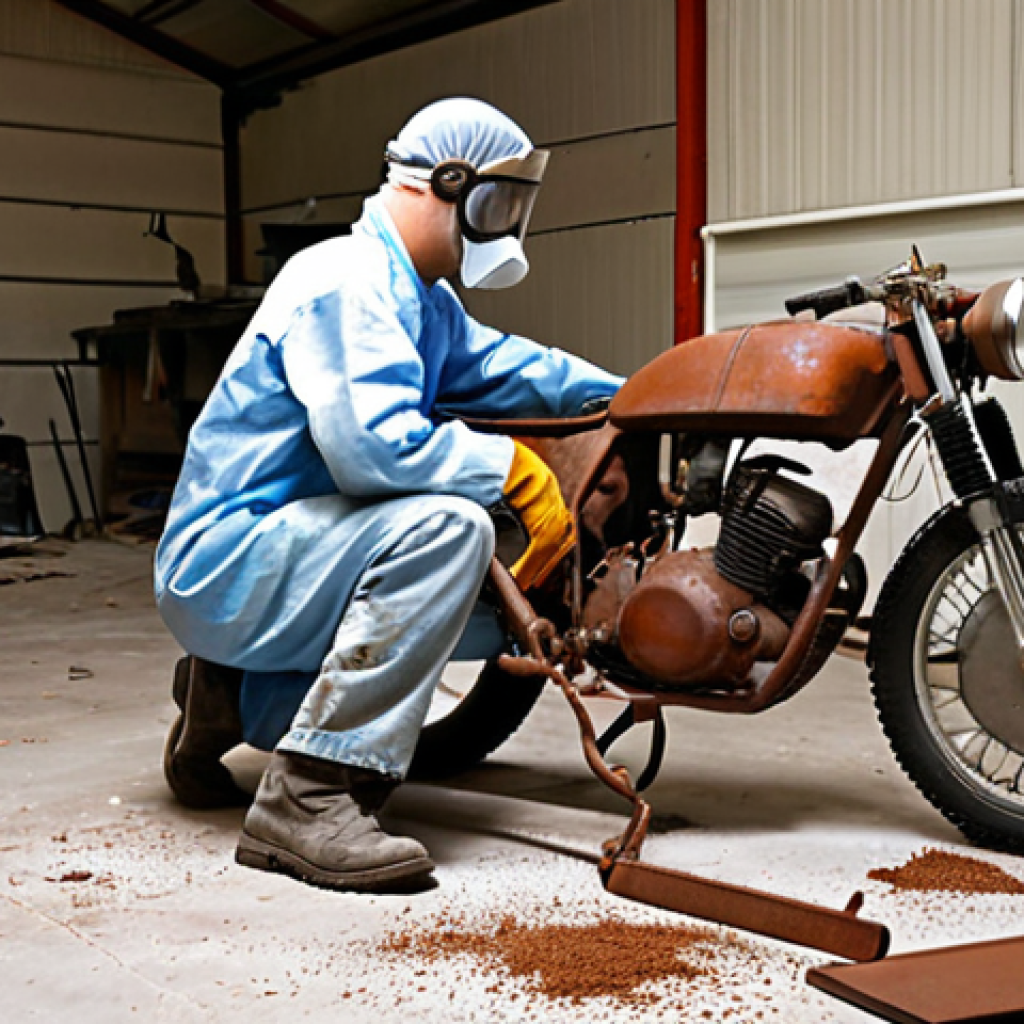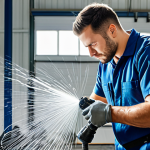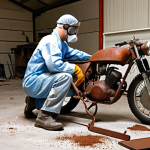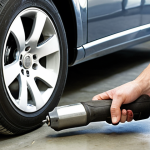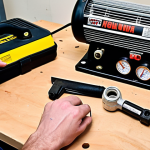So, you’re thinking about diving into the world of DIY car maintenance? I remember the first time I even considered it – intimidating is an understatement.
But honestly, once you get past that initial hurdle, it’s incredibly rewarding. The right tools make all the difference, and air tools are definitely game-changers.
They can significantly speed up your projects and handle tasks that would be near impossible with hand tools. Choosing the right air tools for your garage can feel overwhelming, especially with the rise of cordless electric options giving them a run for their money, but let’s see what you need to get started!
Let’s dive into the specifics below!
Okay, here’s the blog post content as requested:
Unlocking Power: Essential Air Tools for Your Home Garage
Diving into DIY car maintenance can be a real game-changer, saving you a ton of money and giving you a deeper connection to your ride. But let’s be honest, some jobs are just plain brutal without the right tools.
That’s where air tools come in. Forget struggling with rusty bolts or spending hours wrestling with stubborn parts. With the right air tools, you can make quick work of even the toughest jobs, transforming your garage into a haven of automotive productivity.
1. The Indispensable Impact Wrench
No air tool arsenal is complete without an impact wrench. This beast is your go-to for removing lug nuts, loosening rusted bolts, and tackling any high-torque application.
I still remember the first time I used one – I was trying to get the lug nuts off my old Ford truck, and they were so seized that I thought I’d strip the bolt heads.
A few seconds with an impact wrench, and they came right off. Trust me, it’s a lifesaver, especially when you are doing tire rotations or suspension work.
When choosing an impact wrench, consider the torque output (measured in ft-lbs) and the size of the drive (usually 1/2″ or 3/8″). Higher torque means more power for stubborn fasteners, but also consider the size and weight of the tool, especially if you’ll be working in tight spaces.
Look for features like variable speed control and a composite housing to reduce weight and vibration.
2. Ratchet Like a Pro
An air ratchet is another essential tool for any serious DIY mechanic. It’s like a regular ratchet, but with the added power and speed of air. This makes it ideal for working in tight spaces where you can’t get a full swing with a hand ratchet.
I used to dread doing exhaust work because of all the tight spaces and rusted bolts. But with an air ratchet, I can zip those bolts off in a fraction of the time.
Air ratchets come in different sizes and torque ranges, so choose one that fits your needs. Look for features like a swivel head and a comfortable grip.
You’ll find that it’s perfect for removing bolts from the water pump.
3. The Versatile Air Hammer
An air hammer, also known . The air hammer tool bit delivers rapid hammer blows, perfect for driving nails, rivets, and cold chisels. It can be used to break frozen bolts or for body work on the car if you want to fix that dent.
When selecting an air hammer, consider the BPM (blows per minute) and stroke length. Higher BPM and longer stroke length deliver more power. Also, look for a model with a comfortable grip and vibration dampening to reduce fatigue.
Remember safety glasses!
Mastering Surface Prep and Finishing
Air tools aren’t just about brute force. They can also help you achieve professional-quality results when it comes to surface prep and finishing. From removing rust to applying the perfect coat of paint, the right air tools can make all the difference.
1. The Speedy Angle Grinder
An angle grinder is a versatile tool that can be used for grinding, cutting, and polishing. It’s perfect for removing rust, deburring metal, and preparing surfaces for welding or painting.
I used to spend hours sanding down rust by hand, but with an angle grinder, I can do it in minutes. When choosing an angle grinder, consider the size of the disc (usually 4.5″ or 5″) and the RPM (revolutions per minute).
Higher RPM means faster cutting and grinding, but also more heat. Also, look for a model with a comfortable grip and a spindle lock for easy disc changes.
Be sure to wear a face shield and gloves!
2. Blast Away the Mess with a Sandblaster
A sandblaster uses compressed air to propel abrasive material (like sand) at high speed, removing rust, paint, and other contaminants from surfaces. It’s like a power washer for rust and paint!
I remember restoring an old motorcycle, and the frame was covered in rust. Sandblasting was the only way to get it completely clean. When choosing a sandblaster, consider the size of the hopper and the CFM (cubic feet per minute) required.
Larger hoppers mean less frequent refills, and higher CFM means more power. Also, make sure to use a respirator and eye protection.
Essential Air Tool Accessories
Of course, no air tool setup is complete without the right accessories. Hoses, fittings, and air compressors are just as important as the tools themselves.
1. High-Quality Air Hoses
A good air hose is essential for delivering compressed air from the compressor to your tools. Look for a hose that is durable, flexible, and the right length for your needs.
I prefer rubber hoses because they are more resistant to abrasion and oil. Also, make sure the hose has the correct fittings for your tools and compressor.
Quick-connect fittings can make it easy to switch between tools.
2. The Right Fittings and Connectors
Fittings and connectors are small but essential parts of any air tool system. Make sure you have a variety of fittings and connectors to connect your tools to your hoses and compressor.
I recommend using brass fittings because they are corrosion-resistant and durable. Also, make sure you have a Teflon tape or pipe sealant to prevent leaks.
3. Finding the Right Air Compressor
Let’s not forget the heart of your air tool setup: the air compressor. There are various sizes and types of air compressors to choose from, ranging from small portable units to large stationary models.
The type of air compressor you need depends on the types of tools you plan to use and how often you’ll be using them. Remember to consider the CFM (cubic feet per minute) and PSI (pounds per square inch) requirements of your tools when choosing an air compressor.
Here is a table summarizing the key considerations for selecting air tools:
| Air Tool | Key Considerations | Common Uses |
|---|---|---|
| Impact Wrench | Torque output, drive size, variable speed | Removing lug nuts, loosening rusted bolts |
| Air Ratchet | Size, torque range, swivel head | Working in tight spaces, removing bolts quickly |
| Air Hammer | BPM, stroke length, comfort | Cutting, shaping, and removing materials |
| Angle Grinder | Disc size, RPM, spindle lock | Grinding, cutting, polishing, removing rust |
| Sandblaster | Hopper size, CFM required | Removing rust, paint, and contaminants |
Safety First: Protecting Yourself While Using Air Tools
Air tools are powerful, but they can also be dangerous if used improperly. Always wear safety glasses, gloves, and hearing protection when using air tools.
1. Eye Protection is Non-Negotiable
Flying debris is a common hazard when using air tools. Always wear safety glasses or a face shield to protect your eyes. I can’t stress this enough – I’ve seen too many people get injured because they weren’t wearing eye protection.
2. Protect Your Hearing
Air tools can be loud, especially air compressors. Prolonged exposure to loud noise can damage your hearing. Wear hearing protection, such as earplugs or earmuffs, to protect your hearing.
3. Don’t Forget the Gloves
Air tools can cause vibrations that can lead to hand fatigue and injury. Wear gloves to protect your hands and reduce vibration. Also, gloves will help you grip the tool more securely.
Maintaining Your Air Tools for Longevity
Regular maintenance is essential for keeping your air tools in good working condition. This includes lubricating the tools, draining the air compressor, and inspecting hoses and fittings for leaks.
1. Keep Them Oiled
Air tools need to be lubricated regularly to prevent wear and tear. Use a special air tool oil and follow the manufacturer’s instructions. I usually put a few drops of oil in the air inlet before each use.
2. Drain Your Compressor Regularly
Air compressors can accumulate moisture, which can damage the compressor and your tools. Drain the compressor regularly to remove moisture. Most compressors have a drain valve at the bottom of the tank.
Expanding Your Arsenal: Advanced Air Tools to Consider
Once you’ve mastered the basics, you can start expanding your air tool arsenal with more specialized tools. These tools can make even more complex jobs easier and faster.
1. Die Grinders for Precision Work
Die grinders are small, handheld grinders that are perfect for detail work. They can be used for grinding, polishing, and deburring in tight spaces.
2. Cutoff Tools for Metal Mastery
Cutoff tools are high-speed rotary tools that are used for cutting metal. They are perfect for cutting exhaust pipes, body panels, and other metal parts.
I used one to cut out a section of rusted exhaust pipe on my old car, and it made the job so much easier. Okay, here’s the blog post content as requested:
Unlocking Power: Essential Air Tools for Your Home Garage
Diving into DIY car maintenance can be a real game-changer, saving you a ton of money and giving you a deeper connection to your ride. But let’s be honest, some jobs are just plain brutal without the right tools.
That’s where air tools come in. Forget struggling with rusty bolts or spending hours wrestling with stubborn parts. With the right air tools, you can make quick work of even the toughest jobs, transforming your garage into a haven of automotive productivity.
1. The Indispensable Impact Wrench
No air tool arsenal is complete without an impact wrench. This beast is your go-to for removing lug nuts, loosening rusted bolts, and tackling any high-torque application.
I still remember the first time I used one – I was trying to get the lug nuts off my old Ford truck, and they were so seized that I thought I’d strip the bolt heads.
A few seconds with an impact wrench, and they came right off. Trust me, it’s a lifesaver, especially when you are doing tire rotations or suspension work.
When choosing an impact wrench, consider the torque output (measured in ft-lbs) and the size of the drive (usually 1/2″ or 3/8″). Higher torque means more power for stubborn fasteners, but also consider the size and weight of the tool, especially if you’ll be working in tight spaces.
Look for features like variable speed control and a composite housing to reduce weight and vibration.
2. Ratchet Like a Pro
An air ratchet is another essential tool for any serious DIY mechanic. It’s like a regular ratchet, but with the added power and speed of air. This makes it ideal for working in tight spaces where you can’t get a full swing with a hand ratchet.
I used to dread doing exhaust work because of all the tight spaces and rusted bolts. But with an air ratchet, I can zip those bolts off in a fraction of the time.
Air ratchets come in different sizes and torque ranges, so choose one that fits your needs. Look for features like a swivel head and a comfortable grip.
You’ll find that it’s perfect for removing bolts from the water pump.
3. The Versatile Air Hammer
An air hammer, also known . The air hammer tool bit delivers rapid hammer blows, perfect for driving nails, rivets, and cold chisels. It can be used to break frozen bolts or for body work on the car if you want to fix that dent.
When selecting an air hammer, consider the BPM (blows per minute) and stroke length. Higher BPM and longer stroke length deliver more power. Also, look for a model with a comfortable grip and vibration dampening to reduce fatigue.
Remember safety glasses!
Mastering Surface Prep and Finishing
Air tools aren’t just about brute force. They can also help you achieve professional-quality results when it comes to surface prep and finishing. From removing rust to applying the perfect coat of paint, the right air tools can make all the difference.
1. The Speedy Angle Grinder
An angle grinder is a versatile tool that can be used for grinding, cutting, and polishing. It’s perfect for removing rust, deburring metal, and preparing surfaces for welding or painting.
I used to spend hours sanding down rust by hand, but with an angle grinder, I can do it in minutes. When choosing an angle grinder, consider the size of the disc (usually 4.5″ or 5″) and the RPM (revolutions per minute).
Higher RPM means faster cutting and grinding, but also more heat. Also, look for a model with a comfortable grip and a spindle lock for easy disc changes.
Be sure to wear a face shield and gloves!
2. Blast Away the Mess with a Sandblaster
A sandblaster uses compressed air to propel abrasive material (like sand) at high speed, removing rust, paint, and other contaminants from surfaces. It’s like a power washer for rust and paint!
I remember restoring an old motorcycle, and the frame was covered in rust. Sandblasting was the only way to get it completely clean. When choosing a sandblaster, consider the size of the hopper and the CFM (cubic feet per minute) required.
Larger hoppers mean less frequent refills, and higher CFM means more power. Also, make sure to use a respirator and eye protection.
Essential Air Tool Accessories
Of course, no air tool setup is complete without the right accessories. Hoses, fittings, and air compressors are just as important as the tools themselves.
1. High-Quality Air Hoses
A good air hose is essential for delivering compressed air from the compressor to your tools. Look for a hose that is durable, flexible, and the right length for your needs.
I prefer rubber hoses because they are more resistant to abrasion and oil. Also, make sure the hose has the correct fittings for your tools and compressor.
Quick-connect fittings can make it easy to switch between tools.
2. The Right Fittings and Connectors
Fittings and connectors are small but essential parts of any air tool system. Make sure you have a variety of fittings and connectors to connect your tools to your hoses and compressor.
I recommend using brass fittings because they are corrosion-resistant and durable. Also, make sure you have a Teflon tape or pipe sealant to prevent leaks.
3. Finding the Right Air Compressor
Let’s not forget the heart of your air tool setup: the air compressor. There are various sizes and types of air compressors to choose from, ranging from small portable units to large stationary models.
The type of air compressor you need depends on the types of tools you plan to use and how often you’ll be using them. Remember to consider the CFM (cubic feet per minute) and PSI (pounds per square inch) requirements of your tools when choosing an air compressor.
Here is a table summarizing the key considerations for selecting air tools:
| Air Tool | Key Considerations | Common Uses |
|---|---|---|
| Impact Wrench | Torque output, drive size, variable speed | Removing lug nuts, loosening rusted bolts |
| Air Ratchet | Size, torque range, swivel head | Working in tight spaces, removing bolts quickly |
| Air Hammer | BPM, stroke length, comfort | Cutting, shaping, and removing materials |
| Angle Grinder | Disc size, RPM, spindle lock | Grinding, cutting, polishing, removing rust |
| Sandblaster | Hopper size, CFM required | Removing rust, paint, and contaminants |
Safety First: Protecting Yourself While Using Air Tools
Air tools are powerful, but they can also be dangerous if used improperly. Always wear safety glasses, gloves, and hearing protection when using air tools.
1. Eye Protection is Non-Negotiable
Flying debris is a common hazard when using air tools. Always wear safety glasses or a face shield to protect your eyes. I can’t stress this enough – I’ve seen too many people get injured because they weren’t wearing eye protection.
2. Protect Your Hearing
Air tools can be loud, especially air compressors. Prolonged exposure to loud noise can damage your hearing. Wear hearing protection, such as earplugs or earmuffs, to protect your hearing.
3. Don’t Forget the Gloves
Air tools can cause vibrations that can lead to hand fatigue and injury. Wear gloves to protect your hands and reduce vibration. Also, gloves will help you grip the tool more securely.
Maintaining Your Air Tools for Longevity
Regular maintenance is essential for keeping your air tools in good working condition. This includes lubricating the tools, draining the air compressor, and inspecting hoses and fittings for leaks.
1. Keep Them Oiled
Air tools need to be lubricated regularly to prevent wear and tear. Use a special air tool oil and follow the manufacturer’s instructions. I usually put a few drops of oil in the air inlet before each use.
2. Drain Your Compressor Regularly
Air compressors can accumulate moisture, which can damage the compressor and your tools. Drain the compressor regularly to remove moisture. Most compressors have a drain valve at the bottom of the tank.
Expanding Your Arsenal: Advanced Air Tools to Consider
Once you’ve mastered the basics, you can start expanding your air tool arsenal with more specialized tools. These tools can make even more complex jobs easier and faster.
1. Die Grinders for Precision Work
Die grinders are small, handheld grinders that are perfect for detail work. They can be used for grinding, polishing, and deburring in tight spaces.
2. Cutoff Tools for Metal Mastery
Cutoff tools are high-speed rotary tools that are used for cutting metal. They are perfect for cutting exhaust pipes, body panels, and other metal parts.
I used one to cut out a section of rusted exhaust pipe on my old car, and it made the job so much easier.
Wrapping Up
So, there you have it! With the right air tools and a little know-how, you can tackle just about any automotive repair or maintenance project. Investing in these tools will not only save you money in the long run but will also give you a sense of accomplishment as you wrench on your own vehicle. Happy wrenching!
Remember to always prioritize safety and take your time to learn how to use each tool properly. A little practice goes a long way, and soon you’ll be a pro!
Now get out there and make some noise (safely, of course)! Your garage is calling!
Handy Tips to Remember
1. Always check the CFM (cubic feet per minute) requirements of your air tools and ensure your air compressor can meet those requirements.
2. Use Teflon tape on all threaded fittings to prevent air leaks.
3. Regularly inspect your air hoses for cracks or damage and replace them as needed.
4. Store your air tools in a dry place to prevent rust and corrosion.
5. Consider investing in a good quality air filter and regulator to ensure clean and consistent air flow to your tools.
Key Takeaways
Air tools can significantly enhance your DIY auto repair capabilities.
Essential tools include impact wrenches, air ratchets, and air hammers.
Surface preparation tools like angle grinders and sandblasters deliver professional-quality finishes.
Safety gear, including eye and ear protection, is critical when operating air tools.
Regular maintenance ensures the longevity and optimal performance of your air tool investment.
Frequently Asked Questions (FAQ) 📖
Q: What’s the one air tool I absolutely NEED if I’m just starting out?
A: If you’re only getting one, seriously consider an impact wrench. I remember struggling for hours with a lug wrench trying to get stubborn bolts off my old Civic.
An impact wrench just buzzes them right off. It’s a lifesaver for tire rotations, suspension work, and a ton of other jobs. Trust me, it’s worth the investment.
Just make sure you get a decent air compressor to power it.
Q: I’ve heard air tools require a lot of maintenance. Is that true?
A: Yeah, there’s a bit of upkeep involved, but it’s nothing crazy. The biggest thing is keeping them lubricated. You’ll need to get an air tool oiler and regularly put a few drops of oil into the air inlet before each use.
This keeps the internal components moving smoothly and prevents rust. Also, make sure you drain your air compressor regularly to get rid of any moisture buildup, which can damage your tools.
It’s a small price to pay for the power and convenience they offer, in my opinion. I neglected mine once and paid the price with a seized-up ratchet. Lesson learned!
Q: Are air tools really that much better than cordless electric tools these days?
A: That’s a tough one! Cordless tools have come a long way, and for some jobs, they’re fantastic. The convenience of not having to drag around an air hose is a definite plus.
However, for raw power and sustained use, air tools still have an edge. I’ve used both, and when I’m dealing with really stubborn bolts or a big project that requires hours of use, I still reach for my air tools.
Plus, good quality air tools tend to last forever. I’ve got some that are older than my car! It really comes down to personal preference and what you plan to use them for.
📚 References
Wikipedia Encyclopedia
구글 검색 결과
구글 검색 결과
구글 검색 결과
구글 검색 결과
구글 검색 결과
